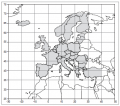If you wish to contribute or participate in the discussions about articles you are invited to contact the Editor
EGNOS Performances: Difference between revisions
No edit summary |
No edit summary |
||
| Line 7: | Line 7: | ||
|Logo=GMV | |Logo=GMV | ||
}} | }} | ||
EGNOS [[GNSS Performances|performances]] are usually described in terms of [[Accuracy|accuracy]], [[Integrity|integrity]], [[Availability|availability]] and [[Continuity|continuity]]. | [[EGNOS]] [[GNSS Performances|performances]] are usually described in terms of [[Accuracy|accuracy]], [[Integrity|integrity]], [[Availability|availability]] and [[Continuity|continuity]]. | ||
==EGNOS Performances Requirements== | ==EGNOS Performances Requirements== | ||
Revision as of 19:32, 30 March 2011
| EGNOS | |
|---|---|
| Title | EGNOS Performances |
| Author(s) | GMV. |
| Level | Basic |
| Year of Publication | 2011 |
EGNOS performances are usually described in terms of accuracy, integrity, availability and continuity.
EGNOS Performances Requirements
The performances required to EGNOS as per the EGNOS Mission Requirement Document[1] are presented in the following table.
| Service | Service Coverage | Accuracy (95%) | Integrity | Continuity | Availability | ||||
|---|---|---|---|---|---|---|---|---|---|
| Lateral | Vertical | HAL | VAL | TTA | Integrity Risk | ||||
| Open Service | EU25 States (plus Norway and Switzerland) land masses | 3m | 4m | - | - | - | - | - | 99% |
| SoL En-route and NPA | FIRs of ECAC 96 | 220m | - | 556m | - | 10s | 1e-7/hour | 1e-5/hour | 99.9% |
| SoL APV-I | Land Masses of ECAC 96 | 16m | 20m | 40m | 50m | 6s | 2e-7/150s | 8e-6/15s | 99% |
Typical Performances
Early 2011, the performances provided by EGNOS are presented in next figures – for day 7th Feb. 2011, considered to be a representative day. The actual EGNOS messages have been taken from the EGNOS Message Server. The images have been generated with the eclayr tool.
Availability: The figure shows EGNOS availability map together with the iso-lines of availability compliance to APV-I service level availability requirements (i.e., HPL < 40 m and VPL < 50 m). The period of analysis corresponds to one day with the inner iso-line delimiting the user locations where a service level over 99% availability is achieved.
Continuity: The figure shows EGNOS continuity map together with the iso-lines of continuity risk compliance to APV-I service level. The continuity risk is computed as the probability of having a continuity event (Protection Levels bigger than Alarm Limits) during a period of 15 seconds provided that the service was available (Protection Levels smaller than Alarm Limits) at the start of the period. The inner iso-line, 1e-4, delimits the user locations which did not have a single continuity event during the analyzed day.
Monitoring of EGNOS Performances
EGNOS performances are being monitored continuously by several entities, such as ESSP[2] and ESA.[3]
The EGNOS performance monitoring done by ESSP[2] includes figures on achieved availability, continuity and integrity. In addition, it forecasts the performances in terms of availability and integrity.
The monitoring done by ESA[3] is twofold. On the one hand, the messages, as broadcast by the EGNOS satellites, are analyzed to determine the status of several parameters, such as the GPS satellites which are augmented by EGNOS, the level of monitoring of the ionosphere over Europe or the achieved protection levels. On the other hand, ESA monitoring environment allows to select different reference stations and depicts the accuracy and integrity obtained for those sites.
Notes
References
- ^ EGNOS Mission Requirements Document, version 2.0, 8th May 2006, Galileo Joint Undertaking
- ^ a b EGNOS performances by ESSP
- ^ a b EGNOS performances by ESA






